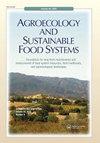The texture of non-fat yogurt with proteins isolates and concentrates
IF 2.6
3区 农林科学
Q1 AGRICULTURE, MULTIDISCIPLINARY
Agroecology and Sustainable Food Systems
Pub Date : 2023-04-07
DOI:10.21323/2618-9771-2023-6-1-29-35
引用次数: 1
Abstract
Yogurt is one of the most common fermented milk products. It is consumed directly as food or used for the production of fermented milk desserts and ice cream. The urgent task for yogurt producers is improving product quality due to additionally introduced protein components. In this study, an effect of protein isolates and concentrates on the rheological parameters of yogurt was evaluated. The methods included the determination of dynamic viscosity and texture indices, such as hardness, gumminess, chewiness, springiness, cohesiveness and adhesiveness. The prepared yogurt samples were investigated immediately and after 30 days of storage at a temperature of 4±2°C. The water-holding capacity was evaluated. It has been established that introduction of whey proteins makes it possible to increase the water-holding capacity to 77% and 80%, respectively. The highest value of dynamic viscosity (19.3 and 26.1 Pa·s) was found in the samples with isolate and concentrate of native whey proteins after 5 hours of fermentation. A decrease in dynamic viscosity with the introduction of milk protein isolate, soy protein concentrate and native whey protein isolate was observed after 5 hours of fermentation. Addition of the protein components led to a significant increase in texture indices, except for cohesiveness. The highest cohesiveness value of 0.4 N·s was found in the sample without protein components and in the sample with whey protein concentrate. The indicators of hardness, gumminess, chewiness, springiness and adhesiveness were the highest in the sample with native whey protein isolate.脱脂酸奶的质地与蛋白质分离和浓缩
酸奶是最常见的发酵乳制品之一。它可以直接作为食物食用,也可以用来制作发酵牛奶、甜点和冰淇淋。酸奶生产商的当务之急是提高产品质量,因为额外引入了蛋白质成分。本研究考察了分离蛋白和浓缩蛋白对酸奶流变参数的影响。方法包括测定动态粘度和质地指标,如硬度、胶性、咀嚼性、弹性、内聚性和粘附性。在4±2°C的温度下保存30天后,立即对制备的酸奶样品进行研究。对其持水量进行了评价。已经确定,引入乳清蛋白可以将保水能力分别提高到77%和80%。天然乳清蛋白分离物和浓缩物发酵5小时后的动态粘度最高,分别为19.3和26.1 Pa·s。发酵5小时后,分别添加分离乳蛋白、大豆浓缩蛋白和天然分离乳清蛋白,动态粘度有所降低。蛋白质组分的添加导致除黏结性外的其他织构指标显著增加。不含蛋白质成分和添加乳清浓缩蛋白的样品的黏结性值最高,为0.4 N·s。硬度、胶性、咀嚼性、弹性和黏附性指标均以天然分离乳清蛋白样品最高。
本文章由计算机程序翻译,如有差异,请以英文原文为准。
求助全文
约1分钟内获得全文
求助全文
来源期刊

Agroecology and Sustainable Food Systems
AGRICULTURE, MULTIDISCIPLINARY-GREEN & SUSTAINABLE SCIENCE & TECHNOLOGY
CiteScore
4.80
自引率
7.70%
发文量
73
期刊介绍:
Agroecology and Sustainable Food Systems is devoted to the rapidly emerging fields of agroecology and food system sustainability. By linking scientific inquiry and productive practice with transformative social action, agroecology provides a foundation for developing the alternative food systems of the future. The journal focuses on the changes that need to occur in the design and management of our food systems in order to balance natural resource use and environmental protection with the needs of production, economic viability, food security, and the social well-being of all people.
Agroecology and Sustainable Food Systems examines our current food systems from production to consumption, and the urgent need to transition to long-term sustainability. The journal promotes the study and application of agroecology for developing alternatives to the complex problems of resource depletion, environmental degradation, a narrowing of agrobiodiversity, continued world hunger, consolidation and industrialization of the food system, climate change, and the loss of farm land. The journal uses a food systems approach, and seeks experiences in agroecology that are on-farm, participatory, change-oriented, and backed by broad-based methodologies of sustainability analysis and evaluation.
 求助内容:
求助内容: 应助结果提醒方式:
应助结果提醒方式:


